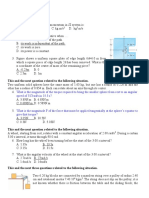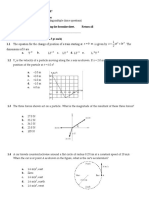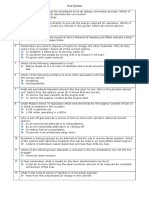Mechanics Good Questions 1.: Z Q P y P R X R Q
Mechanics Good Questions 1.: Z Q P y P R X R Q
Uploaded by
rajdeepCopyright:
Available Formats
Mechanics Good Questions 1.: Z Q P y P R X R Q
Mechanics Good Questions 1.: Z Q P y P R X R Q
Uploaded by
rajdeepOriginal Description:
Original Title
Copyright
Available Formats
Share this document
Did you find this document useful?
Is this content inappropriate?
Copyright:
Available Formats
Mechanics Good Questions 1.: Z Q P y P R X R Q
Mechanics Good Questions 1.: Z Q P y P R X R Q
Uploaded by
rajdeepCopyright:
Available Formats
Mechanics Good Questions
1.
A particle moves in the X Y plane with constant acceleration A directed along
negative Y-direction. The equation of motion of the particle is given by
y x x 2 where & are constants. Calculate the velocity of the particle at
the
origin.
2.
Calculate the maximum value of m3 if the block m1 is not to slip on m 2 while m2 is
sliding over the surface. (m1 = 2 kg, m2 = 4 kg)
m1
s 0.4
m2
k 0.2
3.
m3
Three small balls A, B and C of masses m, 2m and m are joined by inextensible
strings as shown. The ball B is given a velocity u perpendicular to AC. Find the
velocities of the three balls when A collides with C. (Motion is in a horizontal plane.
Assume A, B & C are so small that they can be taken as point masses)
u
m
A
2m
m
C
Top View
4.
A point moves rectilinearly with deceleration whose modulus depends on the velocity
of the particle as k where k is a positive constant. At the initial moment the
velocity of the point is V0 . What will be the distance it travels before coming to a
stop? What time will it take to cover the distance?
5.
A particle moves along a straight line with constant acceleration. If x, y and z be the
distances described by the particle during the pth, qth and rth second respectively. What
is the value of q r x r p y p q z ?
6.
A small block starts sliding down an inclined plane of inclination . The coefficient
of friction varies with distance covered as kx , where k is a constant. Find the
distance covered by the block till it stops and its maximum velocity over the distance.
Page 1 of 4
7.
A 0.5 kg block slides from the point A. (see fig.) on a horizontal track with an initial
speed of 3 m/s towards a weightless horizontal spring of length 1 m and force
constant 2 N/m. The part AB of the track is frictionless and the part BC has the
coefficients of static and kinetic friction as 0.22 and 0.2 respectively. If the distances
AB and BD are 2 m and 2.14 m respectively, find the total distance through which the
block moves before it comes to rest completely. (Take g = 10 m/s2).
A
8.
A string, with one end fixed on a rigid wall, passing over a
fixed frictionless pulley at a distance of 2 m from the wall,
has a point mass M = 2 kg attached to it at a distance of 1 m
from the wall. A mass m = 0.5 kg attached at the free end is
held at rest so that the string is horizontal between the wall
and the pulley and vertical beyond the pulley. What will be
the speed with which the mass M will hit the wall when the
mass m is released? (Take g = 9.8 m/s2)
9.
A bullet of mass M is fired with a velocity 50 m/s at an angle with the horizontal.
At the highest point of its trajectory, it collides head on with a bob of mass 3M
suspended by a massless string of length 10/3 m and gets embedded in the bob. After
the collision the string moves through an angle of 1200. Find
(a) the angle ,
(b) the vertical and horizontal coordinates of the initial position of the bob with
respect to the point of firing of the bullet. (Take g = 10 m/s2)
10.
A particle is suspended vertically from a point O by an
inextensible massless string of length L. A vertical line
is at a distance L/8 from O as shown in figure. The object
is given a horizontal velocity u. At some point, its motion
ceases to be circular and eventually the object passes
through the line AB. At the instant of crossing AB, its
velocity is horizontal. Find u.
AB
O
L/8
L
B
u
B
Page 2 of 4
11.
Two blocks A and B are connected to each other by a string and a spring; the string
passes over a frictionless pulley
B
C
A
as shown in the figure. Block B slide over the horizontal top surface of a stationary
block C and the block A slides along the vertical side of C, both with the same
uniform speed. The coefficient of friction between the surfaces of blocks is 0.2. Force
constant of the spring is 1960 N/m. If mass of block A is 2 kg. Calculate the mass of
block B and the energy stored in the spring
12.
Two springs have spring constants k1 & k2 (k1 > k2). On which spring is more work
done when
(a) their length is increased by the same amount.
(b) they are stretched with the same force.
13.
A 50 kg boy and a 40 kg girl are standing on opposite ends of a 20 kg platform. The
boy and the girl begin to approach each other find the displacement of the platform
when the two meet in terms of the displacement x0 of the boy relative to the platform.
The length of the platform is 6 m and it is placed on a smooth ground.
14.
F
M
15.
1
2
What is the
maximum value
of F so that
Mass M does not rotate?
1
2
The velocity of a projectile when it is at the greatest height is
2
times its velocity
5
when it is half its greatest height. Determine the angle of projection.
16.
Find the velocity of a projectile when it is at a height h, in terms of u, g and h.
17.
A projectile is projected with a speed u from the top of tower of height H. Calculate
the maximum range on the ground.
18.
What minimum speed must a particle be projected from the origin so that it is able to
pass through a given point P (a, b)?
Page 3 of 4
19.
A ball is projected with a speed u at an angle ' ' from a point on the ground. Find
the time after which the velocity becomes perpendicular to the velocity of projection.
Air resistance can be neglected.
20.
A particle is thrown over a triangle from one end of a horizontal base and after
grazing the vertex falls on the other end of the base. If and are the base angles
and the angle of projection, prove that
tan tan tan
21.
A shell breaks into two equal parts at the highest point of its path, 19.6 m from the
ground and at a horizontal distance of 1000 m from the point of firing. After two sec,
one of the pieces, say the first, hits the ground at a point vertically below the point
where the shell broke. Calculate
(a) the velocity of the shell before breaking
(b) the velocity of the first part immediately after the shell broke
(c) the velocity of the second part immediately after the shell broke
(d) the distance between the point of firing and the point at which the second part of
the shell hits the ground. (Take g = 9.8 m/s2)
Page 4 of 4
You might also like
- Physics IUP ITB MOMENTUM and IMPULSE SoalNo ratings yetPhysics IUP ITB MOMENTUM and IMPULSE Soal9 pages
- Part - I: Subjective Questions: Section (A) : Calculation of Centre of MassNo ratings yetPart - I: Subjective Questions: Section (A) : Calculation of Centre of Mass14 pages
- (Centre of Mass, Momentum & Collision) Exercise-INo ratings yet(Centre of Mass, Momentum & Collision) Exercise-I4 pages
- Centre of Mass & Consv of Momentum (Nitin M Sir) PDFNo ratings yetCentre of Mass & Consv of Momentum (Nitin M Sir) PDF5 pages
- Part - I: Subjective Questions: Section (A) : Calculation OF Centre of MassNo ratings yetPart - I: Subjective Questions: Section (A) : Calculation OF Centre of Mass26 pages
- Centre of Mass & Consv of Momentum (Nitin M Sir)0% (1)Centre of Mass & Consv of Momentum (Nitin M Sir)5 pages
- Center of Mass - 984a8dcc Ae61 441d Aebc 8cb60d6692c6No ratings yetCenter of Mass - 984a8dcc Ae61 441d Aebc 8cb60d6692c631 pages
- Physics Assignment Sheet Topic: (Collision & Centre of Mass) SECTION BNo ratings yetPhysics Assignment Sheet Topic: (Collision & Centre of Mass) SECTION B6 pages
- Askiitians: Class: Xi Subject: Physics Topic: Motion in A Plane No. of Questions: 30No ratings yetAskiitians: Class: Xi Subject: Physics Topic: Motion in A Plane No. of Questions: 307 pages
- Yang F=ma Intensive Practice Camp Mock-6No ratings yetYang F=ma Intensive Practice Camp Mock-65 pages
- Sheet Exercise 2 - WEP - S-2 1683019532469No ratings yetSheet Exercise 2 - WEP - S-2 16830195324696 pages
- Yang F=ma Intensive Practice Camp Mock-6-SolutionsNo ratings yetYang F=ma Intensive Practice Camp Mock-6-Solutions16 pages
- Assignment I - Spring 2021 - PHY101 - 03No ratings yetAssignment I - Spring 2021 - PHY101 - 032 pages
- Centre of Mass Linear Momentum and Collision PDFNo ratings yetCentre of Mass Linear Momentum and Collision PDF4 pages
- Physics - Class Xii - Jee-Advanced (Work, Power and Energy & Circular Motion) - TestNo ratings yetPhysics - Class Xii - Jee-Advanced (Work, Power and Energy & Circular Motion) - Test7 pages
- Portable Multi-Gas Detector GC310 - CO2, O2No ratings yetPortable Multi-Gas Detector GC310 - CO2, O22 pages
- Process Operation Manual For Clinker Burning System100% (1)Process Operation Manual For Clinker Burning System109 pages
- A Practical Approach For Determining The Grounding Grid PDFNo ratings yetA Practical Approach For Determining The Grounding Grid PDF6 pages
- Loznen S. Electrical Product Compliance... Safety Eng. Vol 2 2021No ratings yetLoznen S. Electrical Product Compliance... Safety Eng. Vol 2 2021333 pages
- UTECH 2000, Additives For Pentane Lamination Rigid FoamsNo ratings yetUTECH 2000, Additives For Pentane Lamination Rigid Foams12 pages
- Model K-843 24VAC & 24VDC Power Supply 120 VAC Input Version P/N 120-5019G1 Installation InstructionsNo ratings yetModel K-843 24VAC & 24VDC Power Supply 120 VAC Input Version P/N 120-5019G1 Installation Instructions14 pages
- Evaluation of Benefit of Solar Reflective Paint in Hot Climate V4No ratings yetEvaluation of Benefit of Solar Reflective Paint in Hot Climate V415 pages
- Yr 11 First Term Exam Practice Questions Oct 2024No ratings yetYr 11 First Term Exam Practice Questions Oct 202421 pages
- Direct Torque Control of Induction MotorNo ratings yetDirect Torque Control of Induction Motor19 pages
- Part - I: Subjective Questions: Section (A) : Calculation of Centre of MassPart - I: Subjective Questions: Section (A) : Calculation of Centre of Mass
- Centre of Mass & Consv of Momentum (Nitin M Sir) PDFCentre of Mass & Consv of Momentum (Nitin M Sir) PDF
- Part - I: Subjective Questions: Section (A) : Calculation OF Centre of MassPart - I: Subjective Questions: Section (A) : Calculation OF Centre of Mass
- Center of Mass - 984a8dcc Ae61 441d Aebc 8cb60d6692c6Center of Mass - 984a8dcc Ae61 441d Aebc 8cb60d6692c6
- Physics Assignment Sheet Topic: (Collision & Centre of Mass) SECTION BPhysics Assignment Sheet Topic: (Collision & Centre of Mass) SECTION B
- Askiitians: Class: Xi Subject: Physics Topic: Motion in A Plane No. of Questions: 30Askiitians: Class: Xi Subject: Physics Topic: Motion in A Plane No. of Questions: 30
- Yang F=ma Intensive Practice Camp Mock-6-SolutionsYang F=ma Intensive Practice Camp Mock-6-Solutions
- Physics - Class Xii - Jee-Advanced (Work, Power and Energy & Circular Motion) - TestPhysics - Class Xii - Jee-Advanced (Work, Power and Energy & Circular Motion) - Test
- Process Operation Manual For Clinker Burning SystemProcess Operation Manual For Clinker Burning System
- A Practical Approach For Determining The Grounding Grid PDFA Practical Approach For Determining The Grounding Grid PDF
- Loznen S. Electrical Product Compliance... Safety Eng. Vol 2 2021Loznen S. Electrical Product Compliance... Safety Eng. Vol 2 2021
- UTECH 2000, Additives For Pentane Lamination Rigid FoamsUTECH 2000, Additives For Pentane Lamination Rigid Foams
- Model K-843 24VAC & 24VDC Power Supply 120 VAC Input Version P/N 120-5019G1 Installation InstructionsModel K-843 24VAC & 24VDC Power Supply 120 VAC Input Version P/N 120-5019G1 Installation Instructions
- Evaluation of Benefit of Solar Reflective Paint in Hot Climate V4Evaluation of Benefit of Solar Reflective Paint in Hot Climate V4

























































































